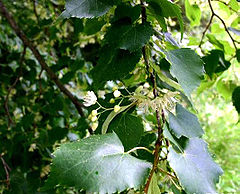Tilia cordata
| Tilia cordata subsp. var. | Little-leaf linden, Small-leafed lime | |||||||||||||||||||||||||||||||||||||||||||||||||||||||
|---|---|---|---|---|---|---|---|---|---|---|---|---|---|---|---|---|---|---|---|---|---|---|---|---|---|---|---|---|---|---|---|---|---|---|---|---|---|---|---|---|---|---|---|---|---|---|---|---|---|---|---|---|---|---|---|---|

|
|
| ||||||||||||||||||||||||||||||||||||||||||||||||||||||
| ||||||||||||||||||||||||||||||||||||||||||||||||||||||||
Tilia cordata (Small-leaved Lime, occasionally Small-leaved Linden) is a species of Tilia native to much of Europe and western Asia, north to southern Great Britain (north to about Durham), central Scandinavia, east to central Russia, and south to central Spain, Italy, Bulgaria, Turkey, and the Caucasus; in the south of its range it is restricted to high altitudes.[1][2]
Tilia cordata is widely grown as an ornamental tree throughout its native range in Europe.
It is a deciduous tree growing to 20-38 m tall, with a trunk up to 1-2 m diameter. The leaves are alternately arranged, rounded to triangular-ovate, 3-8 cm long and broad, mostly hairless (unlike the related Tilia platyphyllos) except for small tufts of brown hair in the leaf vein axils - the leaves are distinctively heart-shaped. The small yellow-green hermaphrodite flowers are produced in clusters of five to eleven in early summer with a leafy yellow-green subtending bract, have a rich, heavy scent; the trees are much visited by bees. The fruit is a dry nut-like drupe 6–7 mm long and 4 mm broad, downy at first becoming smooth at maturity, and (unlike T. platyphyllos) not ribbed.[1][3]
It readily hybridises with Tilia platyphyllos; the hybrid is named Tilia × europaea (syn. T. × vulgaris).[1][4]
In Britain it is becoming increasingly rare and is an indicator of ancient woodland.[5]
| Standard Cyclopedia of Horticulture |
|---|
|
Tilia cordata, Mill. (T. ulmifolia, Scop. T. parvifolia, Ehrh. T. microphylla, Vent. T. silvestris, Desf. T. europaea, Linn., in part). Small-leaved Linden. Fig. 3813. Tree, to 100 ft.: young branchlets at first slightly pubescent, soon glabrous: lvs. suborbicular, often broader than long, cuspidate, cordate at the base, regularly serrate with short-pointed teeth, dark green and somewhat lustrous above, glaucous and glabrous beneath with brown axillary tufts l 1/2 – 2 1/2 in. long; petioles about half as long as blade: fls. 5-7 in nearly upright cymes; style glabrous: fr. globose, slightly ribbed, apiculate, tomentose, with thin fragile shell. July. Eu. Var. pyramidalis, Wittm. Of narrow pyramidal habit. CH
|
Cultivation
- Do you have cultivation info on this plant? Edit this section!
Propagation
- Do you have propagation info on this plant? Edit this section!
Pests and diseases
- Do you have pest and disease info on this plant? Edit this section!
Species
Gallery
If you have a photo of this plant, please upload it! Plus, there may be other photos available for you to add.
-
photo 1
-
photo 2
-
photo 3
References
- Standard Cyclopedia of Horticulture, by L. H. Bailey, MacMillan Co., 1963
External links
- w:Tilia cordata. Some of the material on this page may be from Wikipedia, under the Creative Commons license.
- Tilia cordata QR Code (Size 50, 100, 200, 500)
- ↑ 1.0 1.1 1.2 Rushforth, K. (1999). Trees of Britain and Europe. Collins ISBN 0-00-220013-9.
- ↑ Den Virtuella Floran: Tilia cordata (in Swedish; with maps
- ↑ Flora of NW Europe: Tilia cordata
- ↑ Flora of NW Europe: Tilia vulgaris
- ↑ Natural England internal website
